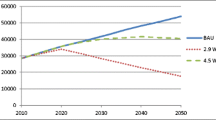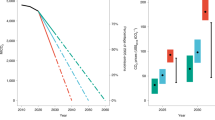Abstract
Following the United Nations Framework Convention on Climate Change1, governments will negotiate, in Kyoto this December, an agreement to mitigate anthropogenic greenhouse-gas emissions. Here we use a model approach to examine optimal CO2-emission abatement paths for specified long-term constraints on atmospheric CO2 concentrations. Our analysis highlights the interplay of uncertainty (in target greenhouse-gas concentrations) and the inertia in the energy systems that produce CO2 emissions. We find that the ‘integrated assessment’ models previously applied to these issues under-represent inertia. A more appropriate representation of inertia increases the costs of deferring abatement and makes it optimal to spread the effort of abatement across generations. Balancing the costs of early action against the potentially higher costs of more rapid and forced later action, we show that early attention to the carbon-emitting potential of new and replacement energy investments will minimize the risk to environmental and economic systems. We conclude that if there is a significant probability of having to maintain atmospheric greenhouse gas concentrations below about double those of the pre-industrial era, then the economic risks associated with deferring abatement justify starting to limit CO2 emissions from energy systems immediately.

Similar content being viewed by others
References
UNFCCC. United Nations Framework Convention on Climate Change, (1992). http://www.unfccc.de/index.html.
IPCC Working Group III Climate Change 1995: Economic and Social Dimensions (Cambridge Univ. Press, (1996).
Hoeller, P., Dean, A. & Hayafui, M. New Issues, New Results: The OECD's Second Survey of Macroeconomic Costs of Reducing CO2 Emissions(OECD Economic Department Working Paper no. 123, Paris, (1992)).
Grubb, M. J., Chapuis, T. & Ha-Duong, M. The economics of changing course: implications of adaptability and inertia for optimal climate policy. Energy Policy 23, 417–432 (1995).
Alcamo, J. & Kreilman, E. Emission scenarios and global climate protection. Global Env. Change 6, 305–335 (1996).
Enting, I. G. Analysing the conflicting requirements of the framework convention on climate change. Clim. Change 31, 5–18 (1995).
Toth, F. L., Bruckner, T., Füssel, H.-M., Leimbach, M. & Petschel-Helld, G. The Tolerable Window Approach to Integrated Assessments(IPCC Asia-Pacific Workshop on Integrated Assessment Models, 10–12 March 1997, Tokyo).
Nordhaus, W. D. Managing the Global Commons: The Economics of Climate Change(MIT Press, Cambridge, MA, (1994)).
Manne, A. S. & Richels, R. G. Buying Greenhouse Insurance: The Economic Cost of CO2 Emissions Limits(MIT Press, Cambridge, MA, (1992)).
Andere, J., Haefele, W., Nakicenovic, N. & McDonald, A. Energy in a Finite World(Ballinger, Cambridge MA, (1981)).
IPCC Working Group I Stabilization of Atmospheric Greenhouse Gases: Physical, BiologicalandSocio-economicImplication (IPCC Technical Paper III, (1997).
Wigley, T. M. L., Richels, R. & Edmonds, J. A. Economic and environmental choices in the stabilization of atmospheric CO2 concentrations. Nature 379, 240–243 (1996).
Hammit, J. K., Lempert, J. R. & Schlesinger, M. E. Asequential-decision strategy for abating climate change. Nature 357, 315–318 (1992).
Enting, I. G., Wigley, T. M. L. & Heimann, M. Future Emissions and Concentrations of Carbon Dioxide: Key Ocean/Atmosphere/Land Analyses(Division of Atmospheric Research, CSIRO, Australia, (1994)). ftp://cdiac.esd.ornl.gov/pub/db1009/.
Grubb, M. Technologies, energy systems and the timing of CO2 abatement: an overview of economic issues. Energy Policy 25, 159–172 (1997).
Acknowledgements
We are grateful to the CNRS, ADEME, the French Ministry of Environment, the Ministry of Education and Research for supporting the Oïkia Programme, and to Shell, BP, Amerada Hess and Ashland Oil for supporting the Belgrave Fellowship of RIIA's Energy and Environmental Programme.
Author information
Authors and Affiliations
Rights and permissions
About this article
Cite this article
Ha-Duong, M., Grubb, M. & Hourcade, JC. Influence of socioeconomic inertia and uncertainty on optimal CO2-emission abatement. Nature 390, 270–273 (1997). https://doi.org/10.1038/36825
Received:
Accepted:
Issue Date:
DOI: https://doi.org/10.1038/36825
- Springer Nature Limited
This article is cited by
-
Paris Climate Agreement passes the cost-benefit test
Nature Communications (2020)
-
Optimal Transition from Coal to Gas and Renewable Power Under Capacity Constraints and Adjustment Costs
Environmental and Resource Economics (2019)
-
Targeted emission reductions from global super-polluting power plant units
Nature Sustainability (2018)
-
Research on carbon market price mechanism and influencing factors: a literature review
Natural Hazards (2018)
-
Global Warming and a Potential Tipping Point in the Atlantic Thermohaline Circulation: The Role of Risk Aversion
Environmental and Resource Economics (2017)





